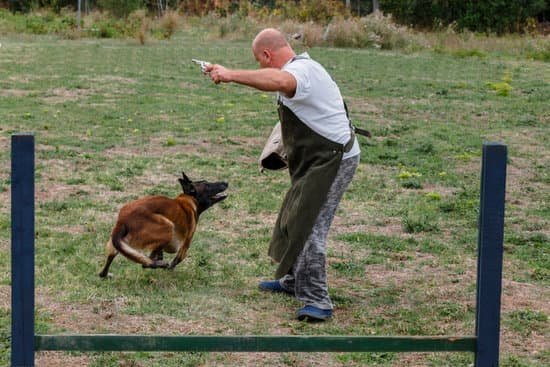Are you tired of chasing after your dogs every time they run away? Learning how to train your dogs not to run away is essential for their safety and your peace of mind. Understanding the reasons why dogs have the tendency to escape is the first step in preventing it from happening. In this article, we will explore various training methods and techniques that can help keep your furry companions close by your side.
One of the most crucial aspects of training your dog not to run away is understanding why they do it in the first place. Whether it’s out of curiosity, fear, or simply because they are not properly trained, identifying the underlying reasons can help you address and prevent escape behavior effectively.
Training your dog to stay by your side is not only important for their safety but also for maintaining a happy and healthy relationship with them. By implementing basic obedience training for recall commands, creating a safe and secure environment, using positive reinforcement techniques, and providing regular exercise and mental stimulation, you can significantly reduce the risk of them running away.
Join us as we delve into each of these strategies in detail, providing you with the knowledge and tools needed to train your dogs effectively. So sit back, relax, and let’s get started on this journey towards keeping your beloved pets close and safe.
Importance of Training Your Dog to Stay by Your Side
Dogs are naturally curious and playful animals, which can lead them to explore their surroundings and sometimes run away. However, it is essential to train your dog to stay by your side for their safety and your peace of mind. By teaching your dog to stay close, you can prevent accidents, loss, or potential dangers that they may encounter when unsupervised. Additionally, a well-trained dog provides a sense of security and companionship for pet owners.
One of the main benefits of training your dog to stay by your side is the prevention of potential hazards and risky situations. Dogs that wander off are exposed to various dangers such as traffic accidents, encountering aggressive animals or getting lost in unfamiliar territory. By consistently reinforcing the “stay” command, you can instill discipline in your dog and keep them safe from harm.
Furthermore, having control over your dog’s movements through training allows for more enjoyable outdoor activities such as walks, hikes, or visits to public spaces. A well-behaved and obedient dog can accompany you on various outings without causing disruptions or posing risks to themselves or others. This creates a harmonious relationship between pet owners and their dogs while fostering trust and reliability between both parties.
| Benefit | Description |
|---|---|
| Preventing Potential Hazards | By training your dog to stay by your side, you can prevent them from encountering traffic accidents or getting lost. |
| Enjoyable Outdoor Activities | A well-trained dog allows for enjoyable outdoor activities such as walks and hikes without disruptions. |
Basic Obedience Training for Recall Commands
Training your dog to respond to recall commands is an essential aspect of preventing them from running away. Recall commands are used to call your dog back to you, especially in situations where they may be tempted to escape or wander off. Basic obedience training for recall commands involves teaching your dog to come when called, regardless of the distractions around them.
One effective method for training recall commands is to use positive reinforcement techniques. This involves rewarding your dog with treats, praise, or affection every time they respond correctly to the recall command. Consistency and patience are key when using this approach, as it may take time for your dog to fully understand and obey the command.
In addition to positive reinforcement, incorporating regular exercise and mental stimulation into your dog’s routine can also help reinforce their training for recall commands. A well-exercised and mentally stimulated dog is more likely to listen and respond to your commands, reducing the likelihood of them trying to run away.
By providing a safe and secure environment, using positive reinforcement techniques, and ensuring consistency in training, you can effectively teach your dog not to run away through basic obedience training for recall commands.
Creating a Safe and Secure Environment for Your Dog
Secure Fencing and Gates
One of the most important steps in preventing your dog from running away is to ensure that your property has secure fencing and gates. Check for any gaps or holes in the fence that your dog may be able to squeeze through, and make sure that the gate is always closed and latched properly. Consider installing a taller fence or adding extensions to prevent your dog from jumping over.
Provide Shelter and Comfort
Dogs often run away if they feel anxious, scared, or uncomfortable in their environment. Make sure that your dog has a comfortable and safe place to rest, such as a cozy dog house or a designated area inside your home. Providing shelter from extreme weather conditions is also essential for keeping your dog secure and content.
Avoid Leaving Your Dog Unattended
Leaving your dog unattended in an open yard can increase the likelihood of escape attempts. If possible, supervise your dog while they are outside, especially during times when they may be more prone to wander off, such as when there are distractions like other animals or people nearby. If you need to leave your dog alone, consider using a crate or enclosed space where they will feel safe and secure.
By creating a safe and secure environment for your dog, you can significantly reduce the risk of them running away. Taking these proactive measures will not only keep your furry friend safe but will also give you peace of mind knowing that they are content and secure in their surroundings.
Using Positive Reinforcement Techniques for Training
When it comes to training your dogs not to run away, using positive reinforcement techniques can be highly effective. Positive reinforcement involves rewarding your dog for good behavior, which encourages them to repeat that behavior in the future. This approach is much more effective than punishment and helps build a strong bond between you and your pet.
Understanding Positive Reinforcement
Positive reinforcement can take many forms, such as giving your dog treats, verbal praise, or even a favorite toy when they exhibit the desired behavior. For example, when you call your dog to come back to you and they respond appropriately, rewarding them with a treat or enthusiastic praise will reinforce the idea that coming back to you is the right thing to do.
Consistency and Timing
Consistency and timing are crucial when using positive reinforcement. It’s important to reward your dog immediately after they exhibit the desired behavior so they can make a clear connection between their action and the reward. Additionally, consistency in rewarding good behavior every time it occurs will help solidify the training.
Using positive reinforcement techniques requires patience and dedication, but it can be incredibly effective in training your dog not to run away. By consistently rewarding good behavior and providing a secure environment, you can help ensure that your furry friend stays safe by your side.
The Role of Exercise and Mental Stimulation in Preventing Escape
Dogs may run away for a variety of reasons, including boredom and a lack of mental and physical stimulation. Providing your dog with enough exercise and mental stimulation is crucial in preventing them from trying to escape.
Dogs are naturally active animals, and without an outlet for their energy, they may become restless and seek ways to satisfy their needs on their own, such as by running away. By incorporating regular exercise and engaging activities into your dog’s daily routine, you can help curb their desire to escape.
One way to prevent escape attempts is by ensuring that your dog receives enough physical activity through daily walks, playtime, and interactive games. This not only helps burn off excess energy but also provides mental stimulation which is equally important in preventing boredom-related behaviors such as trying to run away.
Mental exercises such as puzzle toys, training sessions, and scent games can keep your dog’s mind engaged and less likely to seek out ways to escape from the home or yard.
In addition to providing physical exercise and mental stimulation, it’s important to consider the breed and individual personality of your dog when determining their activity needs. Some breeds require more exercise than others, so it’s essential to tailor your approach based on the specific requirements of your canine companion. By understanding the role of exercise and mental stimulation in preventing escape, you can create a fulfilling environment for your dog that reduces the likelihood of them running away.
| Preventing Escape | Key Points |
|---|---|
| Regular Exercise | Daily walks, playtime, interactive games |
| Mental Stimulation | Puzzle toys, training sessions, scent games |
| Consider Breed & Personality | Tailor approach based on specific requirements |
Proper Identification and Microchipping for Added Security
Many pet owners underestimate the importance of proper identification and microchipping for their dogs, but it can be crucial in preventing them from running away. Here are some key points to consider when it comes to proper identification and microchipping for added security:
- Identification tags: One of the simplest and most effective ways to ensure your dog can be returned to you if they wander off is by using an identification tag. This should include your dog’s name, your contact information, and any important medical information, such as allergies or special needs.
- Microchipping: In addition to ID tags, microchipping your dog provides an extra layer of security. A microchip is a tiny implant that is injected under your dog’s skin, typically between the shoulder blades. This chip contains a unique identification number that can be scanned by veterinarians or animal shelters, allowing them to access your contact information and reunite you with your pet.
- Regularly update information: It’s essential to keep your dog’s identification information up-to-date. If you move or change phone numbers, make sure to update the details on their ID tag and microchip registration. This will ensure that anyone who finds your dog can easily get in touch with you.
By taking these steps to properly identify and secure your dog, you’ll have peace of mind knowing that they have a better chance of being returned safely if they ever run away. This added layer of protection can make a significant difference in keeping your furry friend safe and sound.
Consistency and Patience
Training your dog not to run away requires consistency and patience. It’s important to remember that changing your dog’s behavior takes time and effort, but the results will be worth it in the end. Here are some tips on how to effectively train your dog to stay by your side:
- Be consistent with your training: Consistency is key when it comes to training your dog. Make sure everyone in the household is on the same page when it comes to implementing training techniques. This will help avoid confusion for your dog and reinforce the desired behavior.
- Practice patience: Training your dog not to run away will take time, so it’s important to be patient. Dogs learn at their own pace, so avoid getting frustrated if progress seems slow. Stay calm and positive during training sessions.
- Use positive reinforcement: Rewarding your dog for staying by your side with treats, toys, or praise can help reinforce the behavior. Positive reinforcement will motivate your dog to continue exhibiting the desired behavior.
By being consistent and patient with your training efforts, you can successfully teach your dog not to run away and ensure they stay safe and secure in their environment. Remember that every dog is different, so it’s important to tailor your training approach based on their individual needs and behaviors.
Dealing With Escape Attempts and Reinforcing Training
Once you have started training your dog to stay by your side and respond to recall commands, it’s important to address any escape attempts and reinforce the training. Dogs may test boundaries or try to run away, especially during the initial stages of training. It’s crucial to handle these situations with patience and consistency to prevent setbacks in their training progress.
When dealing with escape attempts, avoid scolding or punishing your dog as it may create negative associations with the training process. Instead, focus on redirecting their attention back to you and using positive reinforcement techniques to encourage them to stay close. This can include using high-value treats, engaging in play, or offering praise when they choose to remain by your side.
Reinforcing the training involves consistently practicing recall commands in various environments and situations. Gradually increase distractions and distances while ensuring that your dog continues to respond promptly. It’s essential to remain patient and reinforce positive behavior while addressing any challenges that may arise. By maintaining a consistent approach, you can further solidify your dog’s understanding of staying close and responding to commands effectively.
As you continue reinforcing the training, remember that every dog is unique, and some may require more time and repetition than others. Be observant of your dog’s behavior and progress, making adjustments as needed to refine their training experience. Consistency and patience are key when reinforcing training efforts, ultimately leading to a stronger bond between you and your furry companion.
Seeking Professional Help if Needed
In conclusion, training your dogs not to run away requires a combination of understanding the reasons behind their behavior, consistent training, creating a safe environment, and using positive reinforcement techniques. It is essential to recognize the importance of keeping your dog by your side for their safety and the peace of mind of their owners. Basic obedience training for recall commands, along with regular exercise and mental stimulation, can significantly reduce the likelihood of escape attempts.
It is also crucial to consider proper identification and microchipping as added security measures in case your dog does manage to escape. Consistency and patience are key in achieving success in training your dog not to run away. If despite all efforts, your dog continues to have escape attempts or shows no improvement in training, seeking professional help from a qualified dog trainer or behaviorist may be necessary.
Remember that every dog is unique, and what works for one may not work for another. Seeking professional help when needed ensures that you are providing the best care for your pet and addressing any underlying issues causing them to run away. With dedication, time, and effort, it is possible to train your dogs effectively and prevent them from running away.
Frequently Asked Questions
How Do You Train a Dog to Come When Called?
Training a dog to come when called requires consistency, patience, and positive reinforcement. Start by using treats or toys to encourage the dog to come when you call their name.
Gradually increase the distance and distractions as the dog becomes more reliable in their response. It’s important to always use a positive and encouraging tone when calling the dog, and never punish them for not coming when called.
How Do I Train My Dog Not to Escape?
To train a dog not to escape, it’s important to first identify why they are attempting to escape in the first place. Is it due to fear, boredom, or simply curiosity?
Once the underlying cause is understood, measures can be taken such as reinforcing boundaries with physical barriers or training the dog using positive reinforcement techniques to stay within a certain area. Providing enough physical and mental stimulation for the dog can also help reduce their desire to escape.
How Do I Train My Dog to Stay?
Teaching a dog to stay involves initially getting them used to holding still for short periods of time before gradually increasing the duration. Start with having them stay for just a few seconds before giving them praise and rewards, then gradually extend the period as they improve.
It’s important for owners to remain consistent and patient during this process, avoiding any punishment if the dog does not stay as commanded. Using clear verbal cues and hand signals can also help reinforce this behavior.

Welcome to the blog! I am a professional dog trainer and have been working with dogs for many years. In this blog, I will be discussing various topics related to dog training, including tips, tricks, and advice. I hope you find this information helpful and informative. Thanks for reading!





